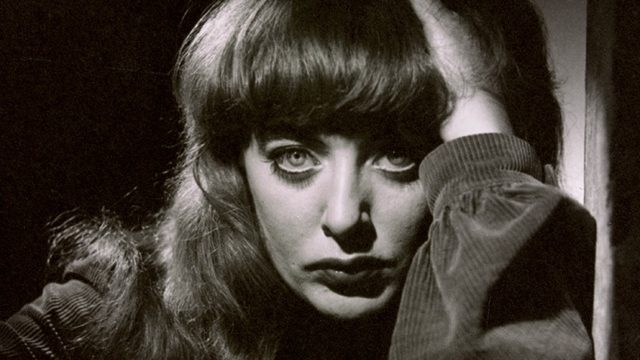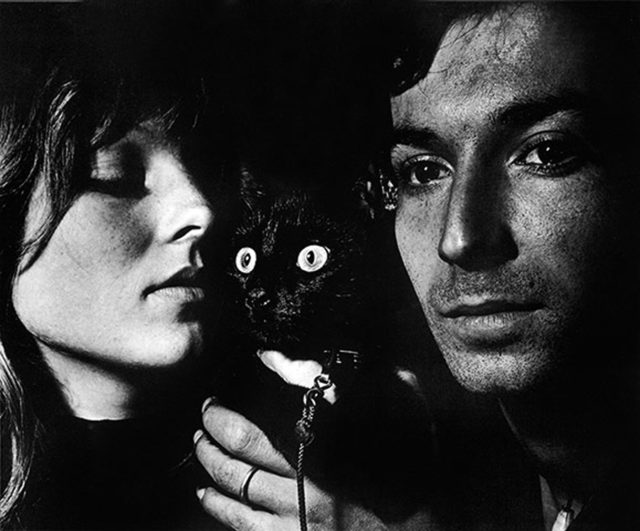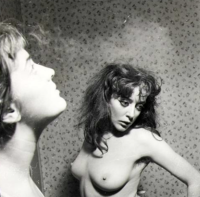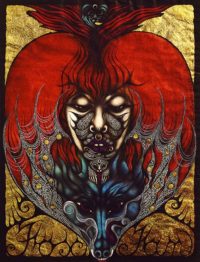Vali Myers

 In 1950, the 25 year old Dutch photographer Ed van der Elsken landed in a shattered, post-war Paris, where he turned his camera on a group of “kindred spirits”; social dropouts in the St. Germain des Prés neighborhood. In a private diary he kept photographic “notes” about their activities, which he was allowed to photograph undisturbed.
In 1950, the 25 year old Dutch photographer Ed van der Elsken landed in a shattered, post-war Paris, where he turned his camera on a group of “kindred spirits”; social dropouts in the St. Germain des Prés neighborhood. In a private diary he kept photographic “notes” about their activities, which he was allowed to photograph undisturbed.
In 1953 fellow photographer Edward Steichen, who was browsing through a series of photos collected for van der Elsken’s first book, pointed out that the photographs had a narrative structure and advised him to create a story. In 1956 the publisher De Bezige Bij released “Love on the Left Bank“, van der Elsken‘s photographs together with a fictional story of unrequited love between the Mexican “Manuel” and “Ann”.
The photography book that resulted is not only regarded as the summit of his work, but is also the first one using the format of a photo novel and internationally recognized as one of the most extraordinary photography books of the 20th century.
Ed van der Elsken’s character of “Ann” was, in reality, the young Australian artist and self-styled Bohemian Vali Myers.
“A story in photographs about Paris – the Paris of the young men and girls who haunt the Left Bank. They dine on half a loaf, smoke hashish, sleep in parked cars or on benches under the plane trees, sometimes borrowing a hotel room from a luckier friend to shelter their love. Some of them write,or paint, or dance. Ed van der Elsken, a young Dutch photographer, stalked his prey for many months along the boulevards, in the cafés and under the shadow of prison walls. Whatever may happen in real life to Ann and her Mexican lover, their strange youth will be preserved ‘alive’ in this book for many years.” – “Love on the Left Bank“, Ed van der Elsken
Vali Myers was born in Sydney, Australia on 2 August 1930, to a violinist mother and marine wireless operator father. She displayed a talent for art at an early age. The family moved to Box Hill, Melbourne in 1941.
At 14, tired of school, Vali left home. She moved into a share house in St Kilda, working at a factory to support herself and pay for ballet classes. By the age of 17 Vali was a lead dancer at the Melbourne Modern Ballet Company. She became renown for her exuberant dance style, wild red hair and heavily kohl-lined eyes.
In 1949 at age 19 Myers traveled to impoverished post-war Paris to pursue a dance career. She was broke within a week and living on the streets, on the Left Bank of Paris, an area notorious for bohemian dwellers. She survived off bread and milk and carried a knife for protection, but Vali made innumerable friends in the bohemian art and film industry. She began making a name for herself, mostly because of her eccentric personality, sense of style, drawings and self-portraits. When she wasn’t drawing, she was dancing in all night cafes and jazz clubs. The writer Gabriel Pommerand described her dancing as ‘a sinuous shuffling, bent-kneed, her shoulders and hands moving at trembling speed to the drumbeats.’
It was also during this time in Paris that Vali became addicted to opium. According to Pommerand, life on the Left Bank of Paris was a ‘confused, vice-enthralled demimonde.’ Opium was a common vice.
But the homeless lifestyle took its toll. Vali was expelled from Paris in 1952 after years of constant harassment over “…vagabondage and association with the crazy Pierre Feuillette…”, who was also photographed by Ed van der Elsken and features in ‘Love on the Left Bank’. After stints in prison for vagrancy, Vali left Paris and began a ‘walkabout’ of France, Italy, Britain, Brussels and finally Austria. In Vienna she met a young architect, Rudi Rappold, who shared Vali’s urge to keep moving. For three years they bummed around from country to country, often harassed by authorities. Finally, in an effort to keep Vali legally in Europe, they married and returned to Paris.
Paris was now awash with a new wave of post-war Anglo Bohemians. The dollar’s exchange rate turned North American artists and writers into neo-aristocrats and Vali mixed with most of the ‘hipster’ set including writers Jean Paul Sartre, Tennessee Williams and Jean Genet.
 Vali’s artwork was first recognized by George Plimpton, writer and founder of The Paris Review. He had known Vali for years and, like many others, was seduced by her sensual dancing and haunting face. Plimpton published a portfolio of her drawings in the Paris Review #18 in the spring of 1958 and wrote an accompanying preface. The writer went on to purchase almost all of Vali’s early work, and the two shared a friendship for many years.
Vali’s artwork was first recognized by George Plimpton, writer and founder of The Paris Review. He had known Vali for years and, like many others, was seduced by her sensual dancing and haunting face. Plimpton published a portfolio of her drawings in the Paris Review #18 in the spring of 1958 and wrote an accompanying preface. The writer went on to purchase almost all of Vali’s early work, and the two shared a friendship for many years.
 In an effort to escape an addiction that was slowly killing her, Vali left Paris in 1958 for the last time. After months of wandering, Vali and Rudi literally stumbled into the wild green valley of ‘Il Porto’ in Positano, Southern Italy. Protected by 1,000-foot cliffs, the almost impenetrable valley opened to the sea and became Vali’s main residence and greatest inspiration.
In an effort to escape an addiction that was slowly killing her, Vali left Paris in 1958 for the last time. After months of wandering, Vali and Rudi literally stumbled into the wild green valley of ‘Il Porto’ in Positano, Southern Italy. Protected by 1,000-foot cliffs, the almost impenetrable valley opened to the sea and became Vali’s main residence and greatest inspiration.
In the early summer of 1971, Italian artist Gianni Menichetti began living with Vali and together took care of the large animal family that developed in the valley. Over the years more animals came to the retreat until Vali had built up a menagerie numbering over one hundred.
After years of battling with local police and government bureaucracy Vali finally obtained permission to turn the valley into a wildlife sanctuary under the protection of the World Wildlife Fund and dedicated all of her money, time and energy into it’s preservation.

 During the 60’s, after years of hibernation from the outside world, the legend of Vali and her artwork began to seep into the consciousness of the new psychedelic generation. In 1965 the American film-maker Sheldon Rochlin produced a documentary on Vali called ‘The Witch of Positano’ and the film became a cult classic in America and was instrumental in attracting some notable visitors to Positano.
During the 60’s, after years of hibernation from the outside world, the legend of Vali and her artwork began to seep into the consciousness of the new psychedelic generation. In 1965 the American film-maker Sheldon Rochlin produced a documentary on Vali called ‘The Witch of Positano’ and the film became a cult classic in America and was instrumental in attracting some notable visitors to Positano.
“Marianne Faithful turned up one day with her boyfriend to see some of my work. I thought, who is this scrawny little guy, so I said to him, what is it you do Micky? How would I know who the bloody hell Mick Jagger was? – I wasn’t interested in Mick Jagger, I was always into Marianne. She was a real fighter.”
British singer Donovan, intrigued by Vali’s artwork also made the trek to Positano. He was so captivated by it’s creator that he flew her to London to have her dance on stage at the Royal Albert Hall to his song, ‘Season of the Witch’. Perhaps the deepest impression was made on the American playwright Tennessee Williams who Vali refers to as ‘the saddest, most sentimental man I have ever known.’ After spending time with Vali, Williams was so taken with her originality and lust for life that he based the free-spirited character Carol, in his play ‘Orpheus Descending’, directly on her.
In 1970, Vali traveled to New York to start concentrating on selling her work for the first time. Flat-broke, she was, nevertheless, reluctant to sell her work for anything less than it was worth. Painstakingly produced by gaslight, each drawing took anything from 6 months to 2 years to complete. Vali’s first supporter in New York was Abbie Hoffman who introduced her to the Chelsea Hotel and its inhabitants. Andy Warhol suggested Vali print reproductions of her work to sell to enthusiasts. It was also at the Chelsea that Vali met a young Patti Smith. Vali’s warpaint had taken on a permanence with intricate facial tattoos and Patti asked Vali to tattoo her knee with a tiny little lightning bolt in ‘tribute to Crazy Horse’.
Salvador Dali praised the quality of Vali’s drawings and urged her to start exhibiting formally. He recommended that Vali show her work in Holland and in 1972 Vali held the first of many exhibitions there. George Plimpton published a second study of Vali’s drawings in #64 of The Paris Review in 1975 and in 1980 he wrote the introduction to her now much sought-after, self-titled book. The book combines Vali’s work from 1949-1979, personal photographs and especially written captions for each drawing in her fabulous calligraphy.
 In 1989, Australian filmmaker, Ruth Cullen, released her beautiful film on Vali Myers, ‘The Tightrope Dancer’. The film perfectly captures Vali’s double life of an almost hermitic, rural existence in Il Porto and her mad, lightning ‘Viking trips’ to New York to sell her work. In the film, Vali talks of her plans to return to Australia and in 1993, she finally made the trip – after an absence of 43 years.
In 1989, Australian filmmaker, Ruth Cullen, released her beautiful film on Vali Myers, ‘The Tightrope Dancer’. The film perfectly captures Vali’s double life of an almost hermitic, rural existence in Il Porto and her mad, lightning ‘Viking trips’ to New York to sell her work. In the film, Vali talks of her plans to return to Australia and in 1993, she finally made the trip – after an absence of 43 years.
In 1995 Vali returned to Australia to set up her beloved studio gallery in the Nicholas Building overlooking Swanston Street in Melbourne and began to show her work regularly.
 Vali Myers died in Melbourne on 12 February 2003 shortly after being diagnosed with cancer at the age of 72.On 18 January 2003, a month before Myers’ death in , The Age newspaper printed an article about her life. The article concluded with the following quote from Myers:
Vali Myers died in Melbourne on 12 February 2003 shortly after being diagnosed with cancer at the age of 72.On 18 January 2003, a month before Myers’ death in , The Age newspaper printed an article about her life. The article concluded with the following quote from Myers:
“I’ve had 72 absolutely flaming years. It doesn’t bother me at all, because, you know love, when you’ve lived like I have, you’ve done it all. I put all my effort into living; any dope can drop dead… I’m in the hospital now, and I guess I’ll kick the bucket here. Every beetle does it, every bird, everybody. You come into world and then you go.”
More:
Photographs of the ‘supreme Beatnik chick’ who inspired Patti Smith (Dangerous Minds)
Vali Myers, the witch of Positano
Vali Myers; A biography by Stephanie Arnel









































Comments
Vali Myers — No Comments
HTML tags allowed in your comment: <a href="" title=""> <abbr title=""> <acronym title=""> <b> <blockquote cite=""> <cite> <code> <del datetime=""> <em> <i> <q cite=""> <s> <strike> <strong>